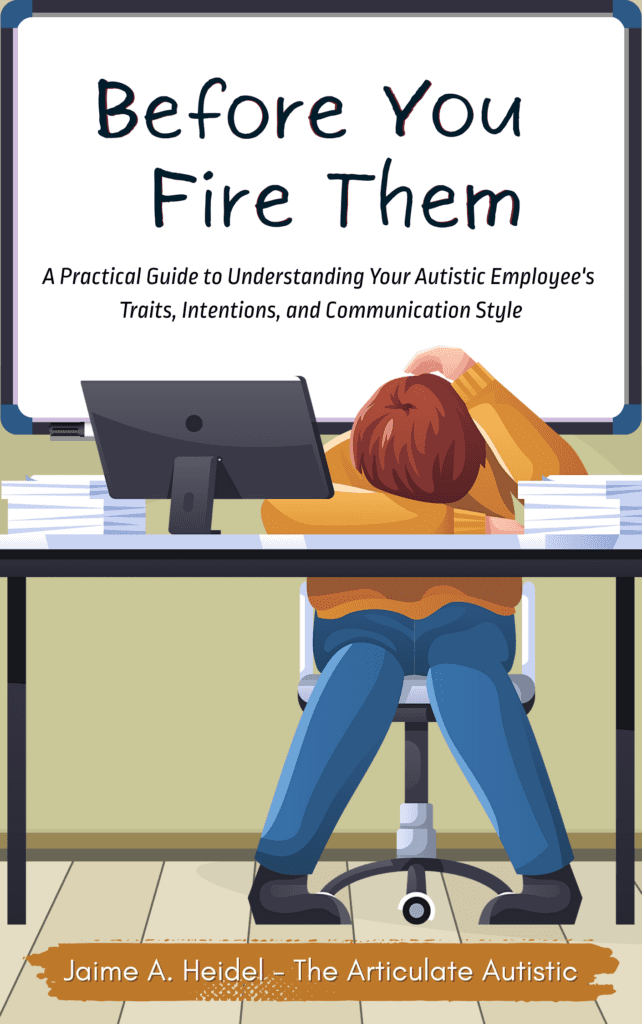“Why Does My Autistic Employee Ask So Many Questions?”

As a manager of autistic employees, you may have found yourself frustratedly asking, “Why does my autistic employee ask so many questions?” more than once.
After all, they’ve done the onboarding process, gone through the training, and worked alongside senior employees who have been showing them the ropes for months.
So, why the questions?
Are they lazy? Messing with your head? Challenging your authority? How are they still not ‘getting it’?
No. Not at all. Nope. And I’ll explain.
Your Autistic Employees Think and Learn Differently
In most cases, the working world is designed with neurotypical (non-autistic) people in mind. The interview process, onboarding, training, and everything beyond and in-between are created to be accessible to the neurological majority.
Because of this, when someone who isn’t in the neurological majority (such as an autistic person) struggles with these basics, the immediate conclusion is that something is ‘wrong’ with the individual–either they’re not smart, they’re doing it on purpose, or both.
The truth is that autistic people think and learn differently than their neurotypical counterparts and being aware of this can go a long way to helping you better understand and work with your neurodivergent hires.
Let’s look at two important differences in autistic versus neurotypical thinking:
- Bottom-up
Most neurotypical people are top-down learners, meaning their brains take pre-existing knowledge and apply it to similar situations and experiences, automatically filling in the details as they go.
Most autistic people, by contrast, are bottom-up thinkers, meaning their learning begins with the details, and they gradually form those details into a whole picture as they go.
Gathering and analyzing individual pieces of information is critical to achieving understanding for bottom-up thinkers, hence the need to ask multiple questions.
- Literal
Neurotypical people are generally good at using and understanding figurative language, such as metaphors and similes. In addition, they tend to use vocal tone, body language, and facial expressions to convey meaning beyond (and sometimes the exact opposite of) the literal word.
Autistic people, by contrast, tend to think and speak in literal, direct language. In other words, we say what we mean, and we mean what we say, and the fact that others don’t do this can cause confusion.
Your autistic employee may ask clarifying questions if they’re unsure about a piece of figurative language you used, or they’re unclear about the intended meaning of your facial expressions, body language, or vocal tone.
Doing this helps them ‘translate’ your communication style into their neurological language, so you both stay on the same page.
Furthermore, asking questions can also be used as a preventative tool. Autistic employees who have several years of employment under their belt may have a history of taking instructions literally when they weren’t meant to be. Clarifying ahead of time may be their way of preventing embarrassing misunderstandings (and reprimands) from recurring.
Questions Are a Critical Key to Autistic Understanding
As I mentioned above, gathering and analyzing individual pieces of information is critical to achieving understanding for someone with a bottom-up thinking style.
Each question answered is another piece of the puzzle that forms the whole picture. Without answers to these questions, your autistic employee cannot access the information they need to perform their job.
Without answers to these questions, your autistic employee cannot access the information they need to perform their job.
“Without answers to these questions, your autistic employee cannot access the information they need to perform their job.”
Jaime A. Heidel – The Articulate Autistic
Moreover, when questions are met with suspicion or rebuke, it adds fear to the confusion, creating an inhospitable working environment for the autistic person.
Questions Are Used to Gather Information, Not Challenge Authority
It wasn’t until I was in my late 30s that I learned questions had a function other than getting answers. The idea that a question could be used as a social weapon of sorts to challenge authority or to make someone look incompetent wasn’t even in my scope of awareness. I couldn’t even conceive of it.
(I know, I probably sound like I’m protesting too much here, but that’s one of those neurotypical social revelations that I never quite get over the shock from.)
All this to say, whether your autistic employee is aware of the alternate functions of questions or not, they’re likely asking theirs to get answers and nothing more.
How to Answer Your Autistic Employee’s Questions Effectively
1) Treat the question as genuine.
The first step to answering your autistic employee’s questions effectively is to receive them as genuine requests for more information and to avoid responding as though they intend to insult.
2) Answer the question literally and directly.
The second step is to avoid figurative language and, instead, answer the question literally and directly. Just the facts.
3) Offer written answers and visual aids.
The third step is to follow your verbal instructions with the same answers in written form. If applicable, you may also include visual aids.
The Takeaway
If your autistic employee is asking questions, chances are, they’re earnestly seeking clarification, not challenging your authority. Answering their questions literally and directly, as well as adding written answers and visual aids, can go a long way in bridging the accessibility gap in the workplace.
My new book, Before You Fire Them: A Practical Guide to Understanding Your Autistic Employee’s Traits, Intentions, and Communication Style, is a supervisor’s best tool to understand and connect with their autistic employees, as it addresses real-world scenarios you encounter every day and offers at-a-glance solutions you can implement immediately!

Looking for more purchasing options? I published through IngramSpark, which is distributing my book globally. The rollout for the paperback is slow, but the eBook is available in several other places. A quick Google search should help you find it in your area. 🙂


